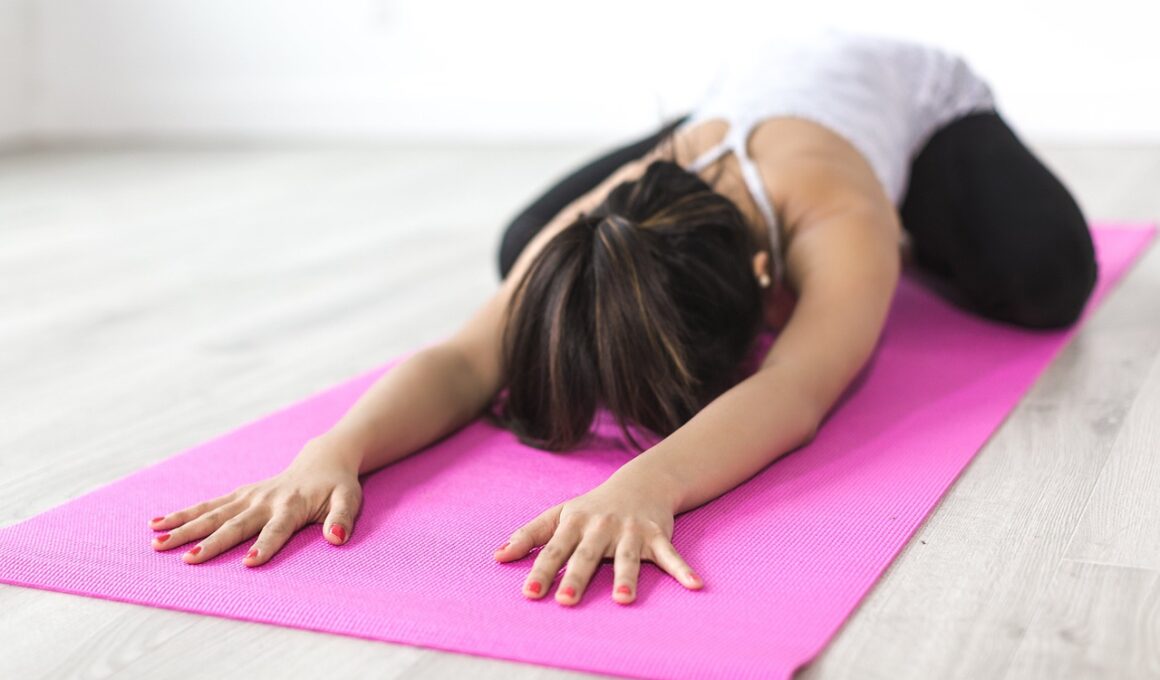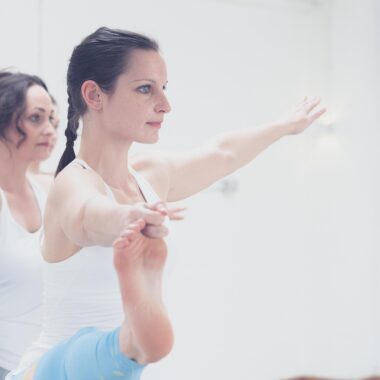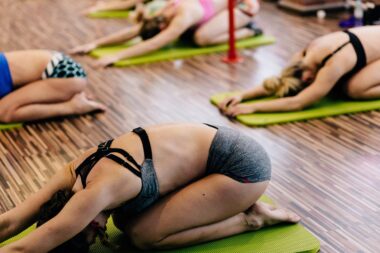Warm-Up Flexibility Exercises for Cross-Functional Fitness Workouts
Incorporating warm-up flexibility exercises is vital for enhancing performance during cross-functional fitness workouts. These flexibility routines prepare the muscles and joints, reducing the risk of injury while increasing overall effectiveness. It’s essential to allocate sufficient time for these exercises before engaging in any high-intensity activities. A few vital warm-up exercises to consider include dynamic stretches and mobility drills. Examples are leg swings, arm circles, and torso twists. These activities allow your body to gradually adapt to the rigorous movements expected in cross-functional training. Dynamic stretching, as opposed to static stretching, is preferred because it keeps muscles engaged and maintains blood flow. Additionally, focusing on major muscle groups such as the hamstrings, quadriceps, and shoulders is crucial. Another aspect to consider is the sequence of warm-up exercises, which can significantly influence flexibility and readiness. Ensuring that the warm-up routine is engaging helps maintain motivation and concentration. Incorporate a variety of movements to enhance balance, coordination, and flexibility. Finally, be mindful of how your body feels during this process, and adjust your routine to suit your specific needs and goals.
Understanding the Importance of Flexibility
Flexibility plays a crucial role in overall fitness, especially in cross-functional training. Improved flexibility aids in executing more complex movements, contributing to better performance across various workouts. The primary benefit of incorporating flexibility exercises is a significant reduction in muscle stiffness. Less stiffness often results in an enhanced range of motion, which is vital for exercises such as squats or lunges. Furthermore, improved flexibility can lead to more efficient movement patterns. Better movement efficiency contributes to enhanced energy utilization during workouts. This becomes especially important during longer training sessions or intense intervals. Engaging in regular flexibility work sets the foundation not just for physical fitness but also for functional movement patterns in daily life. Embracing flexibility routines cultivates resilience in your muscles and joints, reducing the likelihood of injuries. As individuals engage in multiple workout modalities, their flexibility can often be neglected, leading to imbalances. Setting aside time to focus on these exercises ensures that all aspects of fitness are addressed and that characteristically rigid areas are given attention. By committing to consistency in flexibility routines, the overall function of the body during workouts will undoubtedly optimize.
Essential warm-up flexibility exercises comprise various movements that target key muscle groups while enhancing mobility. One effective routine includes the “Standing Quad Stretch,” which stretches the quadriceps, preventing tightness. Begin by standing on one leg, then flex the other knee to bring the heel to the glutes. Hold for a few seconds, and switch legs. Next, incorporate the “Hip Flexor Stretch,” where you take a step forward into a lunge position, opening the hip flexor of the trailing leg. Additionally, include the “Seated Forward Bend” to target the hamstrings and lower back. Sitting with legs extended, bend forward, reaching towards the feet. Each of these stretches should be held for approximately 15-30 seconds for maximum effect. Remember to breathe deeply during each stretch. As you progress through these exercises, aim to increase the depth of the stretch gradually. A strong emphasis on breath helps in relaxation, facilitating better muscle release. Furthermore, dynamic stretches, such as leg swings, can be added to enhance joint mobility. These movements effectively prepare your body for more rigorous activities without overextending muscles excessively.
Progressing Through Flexibility Exercises
Once basic warm-up flexibility exercises are mastered, consider progressing to more advanced variations. For instance, you can enhance the “Hip Flexor Stretch” by incorporating a twist, allowing for a deeper opening of the hip area. This variation not only increases flexibility but also engages core muscles, maximizing the benefits. Another excellent progression is implementing the “Side Lunge Stretch” to open the inner thighs while stretching the groin. By gradually transitioning into these advanced movements, individuals challenge their bodies and avoid stagnation in flexibility gains. Also, yoga poses such as the “Cat-Cow” and “Downward Dog” can be integrated into warm-up routines. These positions promote spinal mobility and lower body flexibility, essential in cross-functional training. Furthermore, incorporating balance exercises like tree pose can greatly enhance stability while achieving greater flexibility. Throughout this progression, it is crucial to maintain awareness of your body’s limits. Listen for feedback from your muscles, adjusting intensity accordingly. A thoughtful approach to progressive flexibility work not only prevents injuries but ensures continuous improvement in overall physical health and performance in cross-functional workouts.
As you integrate warm-up flexibility exercises into your regular routine, consistency is key for achieving long-term benefits. Aim to practice these exercises four to five times a week, especially before engaging in any challenging workouts. It is essential to remember that flexibility improvements won’t happen overnight. Therefore, patience and commitment are necessary. Keep a journal to track your progress and see how your flexibility evolves over time. This can serve as a motivating factor when you notice tangible improvements. Additionally, it’s essential to maintain a balanced diet, as nutrients play a crucial role in muscle recovery and flexibility. Consuming adequate protein, healthy fats, and fiber aids muscle repair after workouts. Keeping hydration in check is equally important, as water is fundamental for overall recovery and flexibility during exercises. Being mindful of your body’s cues also contributes to improving flexibility effectively. If a particular stretch causes discomfort, try modifying it, and find a version that works. Also, ensure to engage in relaxing activities outside of workouts, such as meditation, to promote overall well-being. This holistic approach to flexibility will reflect positively in cross-functional fitness routines.
Incorporating Flexibility Warm-Ups into Workouts
When planning your cross-functional workouts, incorporating warm-up flexibility routines is crucial for maximizing effectiveness. A well-rounded session should ideally begin with five to ten minutes of dedicated flexibility exercises. This not only prepares the body for subsequent high-intensity activities but sets a focused mindset for the workout ahead. Moreover, you can tailor flexibility routines according to the main workout focus. For example, if the day’s workout emphasizes leg strength, allocate extra time to stretch hip flexors and hamstrings. Prepare upper body movements before bench presses or overhead lifts by implementing shoulder and chest openers in your warm-up. As you become more proficient, experiment with combining active flexibility exercises with cardiovascular warm-ups. Activities like jumping jacks or skipping ropes maintain elevated heart rates while promoting flexibility. Overall, tailoring warm-ups to specific workout types increases overall performance and reduces injury risk. Additionally, encourage your training partners to engage in these routines together, fostering accountability while enhancing enjoyment. A collaborative approach to warm-up flexibility exercises builds community support and enhances motivation throughout the sessions, leading to better overall results.
In conclusion, warm-up flexibility exercises are an integral aspect of cross-functional fitness workouts. Prioritizing these routines results in many benefits including enhanced performance, reduced injury risk, and improved overall physical condition. Emphasizing consistency and progression while engaging in warm-ups will deliver significant results over time. Make it a habit to structure workouts by first incorporating tailored flexibility routines based on the exercises that will follow. Encourage others in your community or training group to embrace flexibility work to cultivate a supportive culture around these essential exercises. Explore varying warm-up techniques that promote both balance and flexibility, further diversifying your fitness approach. A comprehensive approach that balances flexibility, strength, and endurance will produce long-lasting fitness results. Finally, recognize that taking the time to prioritize warm-up exercises demonstrates a commitment to overall well-being and health. Take pride in investing in your physical capabilities. Embrace the journey and enjoy the progress as you develop a more flexible, mobile, and capable body that performs effectively in various workout environments.





